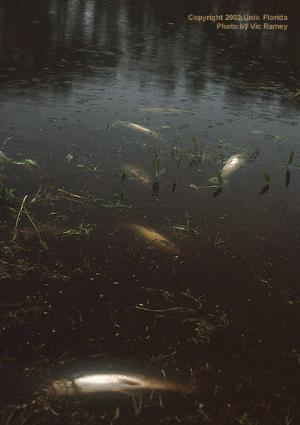Fish Kills
A fish kill is an event in which numerous dead fish are suddenly observed in a waterbody. Fish kills can be dramatic and disturbing and appear harmful to the fish population. However, typical fish kills only affect a small percentage of fish in the waterbody. Fish kills may occur for several reasons.
Low Dissolved Oxygen

Signs of a fish kill
The most common cause of fish kills is related to the depletion of dissolved oxygen in shallow waterbodies. Oxygen depletion may be caused in various ways:
- When aquatic organisms die, oxygen is pulled from the water and used in the decay process. Oxygen can become critically reduced during this process, especially in waterbodies that have an abundance of algae. In waterbodies where the concentration of total chlorophyll exceeds 100 micrograms per liter, (indicating a high algae level), a fish kill can be caused by oxygen depletion. This is due to the large quantity of naturally decomposing algae consuming oxygen, thereby reducing oxygen levels.
- Similarly, oxygen depletion can occur when large amounts of aquatic plants die within a short time. To prevent this, herbicide applicators commonly treat only small areas of aquatic plants at one time. Or, they use herbicides that cause plants to die slowly. They also take dissolved oxygen readings prior to herbicide applications as a precaution.
- A fish kill due to oxygen depletion can also be triggered by several days of overcast skies, especially during hot weather. This happens because aquatic plants and algae add oxygen to the water only when there is sufficient sunlight for photosynthesis. However, they consume oxygen all the time in their normal biological processes. When overcast skies persist for several days, oxygen levels become depleted because the plants are using more oxygen than they are producing. Waters are particularly vulnerable when the temperature is high, because warmer water contains less oxygen to start with than cooler water. Fish "gulping" at the surface may be a sign of an oxygen problem.
Cold Weather Fish Kills
Some species of fish naturally die in large numbers after spawning or when they are stressed by unusual or harsh weather conditions.
When water or air temperatures fall below a critical level for a particular species (scientifically termed a lower lethal temperature), they will die. For example, humans can die due to hypothermia when their body core temperature falls below a critical level. Florida has a sub-tropical climate and often has mild winters. Exotic tropical fish have become established or extended their range further into north Florida. When we have record-setting cold temperatures, our water temperatures can rapidly fall below the lethal temperature for many species. This can result in large die-offs of tropical fish such as blue tilapia and suckermouth catfish, among others.
In addition to exotic fish, some of our native fish are also prone to cold weather-induced kills. Gizzard and threadfin shad often die during cold weather. In Florida, we also have the Florida subspecies of largemouth bass that has evolved in Florida's subtropical climate. Florida largemouth bass can die due to low water temperatures, while the "northern" largemouth bass survives. Marine species such as common snook, tarpon, and sea trout can also die, especially if they are located in shallow areas that experience rapid drops in water temperature.
Even if fish don't immediately die due to cold weather, they will often become stressed, making them more susceptible to illnesses such as bacterial and fungal infections. They may die or have temporary sores on their bodies.
Other Causes
Most fish kills are due to naturally occurring biological occurrences. Observations are critical in determining the cause of a fish kill. One should write down a description of all living and dead animals in and around the pond (i.e., crayfish, turtles, frogs). Record the number, size and species of dead fish as well as any unusual behavior of live fish, such as swimming near the surface or jumping onto the bank.
The Bad News
- Fish kills occur frequently in Florida and most of them are from natural causes.
- It is difficult to predict when a fish kill will occur.
- Even if a fish kill is predicted, there is not much that can be done to prevent it, especially in larger waterbodies.
The Good News
- In the event of a fish kill, you may see a lot of dead fish but there are usually a lot more still alive.
- If water quality declines, there are often many refuges for fish to escape to.
- Because fish lay many eggs, their reproductive potential is usually strong. As a result, their populations are generally able to rebound from a fish kill within a couple of years.


